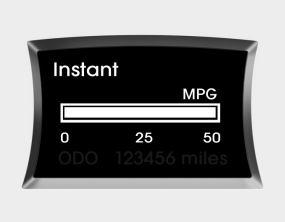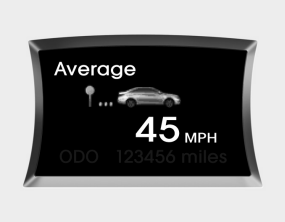 Hyundai Sonata: Gauges
Hyundai Sonata: Gauges

Speedometer
The speedometer indicates the speed of the vehicle.
The speedometer is calibrated in miles per hour and/or kilometers per hour.

Tachometer
The tachometer indicates the approximate number of engine revolutions per minute (rpm).
Use the tachometer to select the correct shift points and to prevent lugging and/or over-revving the engine.
When the door is open, or if the engine is not started within 1 minute, the tachometer pointer may move slightly in ON position with the engine OFF. This movement is normal and will not affect the accuracy of the tachometer once the engine is running.
CAUTION
Do not operate the engine within the tachometer's RED ZONE. This may cause severe engine damage.

Engine temperature gauge
This gauge shows the temperature of the engine coolant when the ignition switch is ON.
Do not continue driving with an overheated engine. If your vehicle overheats, refer to “If the engine overheats” in section 6.
CAUTION
If the gauge pointer moves beyond the normal range area toward the “H” position, it indicates overheating that may damage the engine.
WARNING
Never remove the radiator cap when the engine is hot. The engine coolant is under pressure and could cause severe burns. Wait until the engine is cool before adding coolant to the reservoir.

Fuel gauge
The fuel gauge indicates the approximate amount of fuel remaining in the fuel tank. The fuel tank capacity is given in section 8. The fuel gauge is supplemented by a low fuel warning light, which will illuminate when the fuel tank is near empty.
On inclines or curves, the fuel gauge pointer may fluctuate or the low fuel warning light may come on earlier than usual due to the movement of fuel in the tank.
WARNING - Fuel gauge
Running out of fuel can expose vehicle occupants to danger. You must stop and obtain additional fuel as soon as possible after the warning light comes on or when the gauge indicator comes close to the E level.
CAUTION
Avoid driving with a very low fuel level. Running out of fuel could cause the engine to misfire, damaging the catalytic converter.

Trip computer
The trip computer is a microcomputer controlled driver information system that displays information related to driving on the LCD screen when the ignition switch is in the ON position. If the battery is disconnected, then all stored driving information (except odometer) is reset.

* : if equipped

Odometer (mi. or km)
The odometer indicates the total distance the vehicle has been driven.
You will also find the odometer useful to determine when periodic maintenance should be performed. The odometer is always displayed until the display is turned off.

Tripmeter (mi. or km)
TRIP A : Tripmeter A
TRIP B : Tripmeter B
This mode indicates the distance of individual trips selected since the last tripmeter reset.
The meter's working range is from 0.0 to 9999.9 miles (0.0 to 9999.9 km).
Pressing the RESET button for more than 1 second, when the tripmeter (TRIP A or TRIP B) is being displayed, clears the tripmeter to zero (0.0).

Distance to empty (mi. or km)
This mode indicates the estimated distance to empty based on the current fuel in the fuel tank and the amount of fuel delivered to the engine. When the remaining distance is below 30 miles (50 km), “---” will be displayed and the distance to empty indicator will blink.
The meter’s working range is from 30 to 999 miles (50 to 999 km).

Average fuel consumption (if equipped) (MPG or l/100 km)
This mode calculates the average fuel consumption from the total fuel used and the distance since the last average consumption reset. The total fuel used is calculated from the fuel consumption input. For an accurate calculation, drive more than 0.03 miles (50 m).
Pressing the RESET button for more than 1 second, when the average fuel consumption is being displayed, clears the average fuel consumption to zero (----). If the vehicle speed exceeds 1.6 MPH (1km/h) after being refueled with more than 1.6 gallons (6 l), the average fuel consumption will be cleared to zero (----).

Instant fuel consumption (MPG or l/100km)
This mode calculates the instant fuel consumption every 2 seconds (supervision type : every 0.2 second) from the driving distance and quantity of fuel injection.

Average speed (MPH or km/h)
This mode calculates the average speed of the vehicle since the last average speed reset.
Even if the vehicle is not in motion, the average speed keeps changing while the engine is running.
Pressing the RESET button for more than 1 second, when the average speed is being displayed, clears the average speed to zero (---).

Elapsed time
This mode indicates the total time traveled since the last driving time reset. Even if the vehicle is not in motion, the driving time keeps increasing while the engine is running.
The meter’s working range is from 00:00~99:59.
Pressing the RESET button for more than 1 second, when the driving time is being displayed, clears the driving time to zero (00:00).

ECO ON/OFF mode (if equipped)
You can turn the ECO indicator on/off on the instrument cluster in this mode. If you push the RESET button for more than 1 second in the ECO ON mode, ECO OFF is displayed in the screen and the ECO indicator turns off.
If you want to display the ECO indicator again, press the RESET button for more than 1 second in the ECO OFF mode and then ECO ON mode is displayed in the screen.
✽ NOTICE
- If the vehicle is not on level ground or the battery power has been interrupted, the “Distance to empty” function may not operate correctly. The trip computer may not register additional fuel if less than 1.6 gallons (6 liters) of fuel are added to the vehicle.
- The fuel consumption and distance to empty values may vary significantly based on driving conditions, driving habits, and condition of the vehicle.
- The distance to empty value is an estimate of the available driving distance. This value may differ from the actual driving distance available.
 Instrument panel illumination
Instrument panel illumination
When the vehicle’s parking lights or headlights are on, push the illumination
control switch left or right to adjust the brightness of the instrument panel illumination.
The illumination ...
 Vehicle setting
Vehicle setting
When the vehicle is at a standstill, pressing the TRIP button for more than 2
seconds with the engine start/stop button in the ON position or engine running,
the LCD screen on the cluster will ...
See also:
Instrument panel illumination
When the vehicle’s parking lights or headlights are on, push the illumination
control switch left or right to adjust the brightness of the instrument panel illumination.
The illumination ...
Transaxle Oil Temperature Sensor. Specifications
Specification
Item
Specification
Type
Negative Thermal Coefficient Type
Operation temperature
-40~165°C [-40~329°F] ...
Clutch Cover And Disc. Repair procedures
Removal
1.
Remove the transaxle assembly. (Refer to "Manual transaxle system"
in MT group)
2.
Remove the clutch cover bolts. No ...
